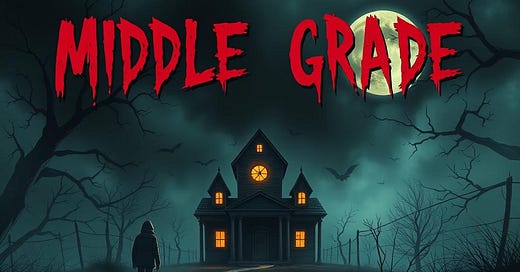Let’s just say it: writing Middle Grade is tough.
It’s tougher than most people give it credit for. Because you’re not just writing for kids—you’re writing for kids and the gatekeepers. Teachers, librarians, homeschool families, bookstore buyers, well-meaning parents with opinions about what’s “appropriate.” And all the while, you’re trying to figure out what will actually make a kid pick up a book, turn the page, and want to keep reading.
It’s a balancing act between voice and values, fun and form, entertainment and trust. And somehow, in the middle of all that, you’ve got to write something that actually matters.
Over the next few issues, I want to take some time to talk about the work of writing Middle Grade across different genres—fantasy, science fiction, horror, humor, and everything in between. Each one comes with its own set of challenges, joys, and unwritten rules.
So today, I want to start with a genre that’s often misunderstood—and sometimes even frowned upon.
Let’s talk about horror.
Not the kind that traumatizes or crosses lines just for shock value. But the kind that actually helps kids grow braver.
The kind that shows them how to face the dark—and keep walking.
Why Middle Grade Horror Isn’t About Fear—It’s About Courage
(And why this age is exactly the right place for it)
I want to shift some thoughts here.
I love this category of fiction—Middle Grade. Some seem to be dismissive of it, brushing it off like it’s too young to matter or too limited to say anything meaningful. But to me, Middle Grade is the best age to write for. Hands down. No contest.
Last week, someone told me my books sounded scary. They said it with a kind of smirk, like they weren’t sure whether to be concerned or impressed. I laughed it off, but it stuck with me. Scary? I mean... maybe? My stories are more comical than terrifying. At least, that’s how I see them. But scary? I guess a giant blob of snot coming to life and chasing kids through the neighborhood could be scary. Or plastic toy dinosaurs that come to life and hunt you down while your mom's trying to make tacos—yeah, I suppose there's some fright baked into that. But really? Scary?
Not really.
But then again—who cares?
Because this is exactly the age where we should be writing scary stories. Not to traumatize kids. Not to give them nightmares. But because horror—especially horror crafted with care and heart for middle grade readers—can actually teach us something.
There’s a critique I’ve heard before. It goes something like this: “You’re tapping into kids’ fears. You’re selling fear.”
No. That’s not true.
Politicians sell fear. They deal in it. They market it, repackage it, and use it to manipulate people into action—or inaction. Fear is their tool. Fear is their product. But us? Middle grade writers dabbling in the strange and spooky?
We’re not selling fear.
We’re selling heroic.
When I write horror for kids, I’m not trying to make them afraid. I’m giving them a playground for courage. A place to rehearse bravery. To test the boundaries of safety and scariness and discover what they’re made of. You think a kid who beats a blob of snot in chapter twelve isn’t going to feel a little more ready to face their real-life bully in the cafeteria tomorrow? Think again.
Middle grade horror gives kids something far more valuable than a cheap scare. It gives them agency.
These stories matter because kids already know the world is scary. They’ve heard the yelling from the other room. They’ve watched the news through the crack in the door. They’ve felt what it’s like to walk into a classroom and not know where to sit. They know fear. What they don’t always know is that it’s possible to face fear and still keep going.
And that’s what middle grade horror does. It doesn’t glorify the monster—it exposes it. It drags it out into the light and says, “There. That’s the thing. Now, let’s figure out how to deal with it.”
And here’s the best part: the hero? It’s not some perfect adult with battle scars and a brooding backstory. It’s not a superhero or a soldier or a genius. It’s a regular kid. Just like them. A kid with awkward shoes and a loud stomach and a backpack that smells faintly of cheese crackers. A kid who gets scared—but doesn’t quit.
That’s what makes this genre so powerful.
Middle grade horror gives kids mirrors to see themselves and maps to navigate their fears. It tells them: you can be small and still be strong. You can be afraid and still choose to act. You don’t have to wait until you’re older to be brave. You can be brave right now.
So no, we’re not selling fear. We’re selling grit. We’re selling wonder. We’re selling the spark that lights up when a kid realizes, Hey... maybe I’ve got what it takes.
We’re teaching kids how to face the dark and keep walking.
We don’t sell fear.
We sell heroic.
I wanted to let you know about a new project I have releasing. Eon City: Burnout! It’s an anthology with 11 stories, 9 authors, set in one city, with one single event. Every story is a reaction to the prologue, and every story interconnects to create one big narrative.
We’re releasing via Kickstarter on May 1st. And we would love to have you follow our campaign. Even if you don’t intend to back, or may not, following helps us out.






Love this!
I've never understood the appeal of ... well... any horror, but this perspective is one I can truly understand and appreciate. Thank you for sharing.
A great article and a cool book concept.